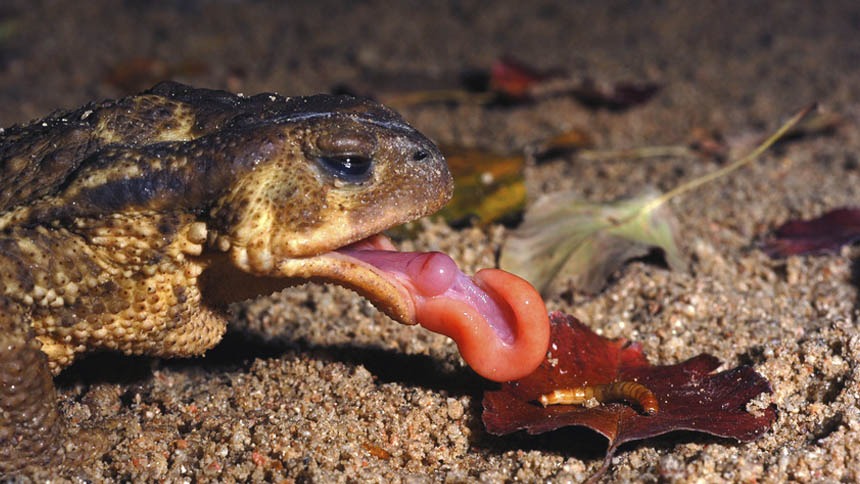
What Do Toads Eat? The Ultimate Guide
A true toad is any species belonging to the Bufonidae family within the Anura (frogs and toads) genus. They’re characterized as having dry, bumpy skin and short, squatty legs.
But what do toads eat? What do you feed pet toads and is it possible to feed wild toads so they’ll stick around your garden?
These are the questions I’ll answer in the sections below.
Toads are carnivorous and enjoy eating live prey. They eat insects and small animals.
- Crickets, Locusts
- Flies, Mosquitos, Moths
- Worms, Grubs (mealworms, waxworms, etc)
- Small rodents like mice
- Fish, Tadpoles
- Lizards, snakes
- Other amphibians
Page Contents
What Toads Eat in the Wild
So what do toads actually eat? Well, toads are carnivores which means they eat live prey. They aren’t very big either; most of them getting no larger than 4 or 5 inches in length.
Due to their size, toads can only eat small, living creatures. Still, they eat a large variety of foods. Mostly insects, worms, small fish and reptiles, rodents, and even other amphibians. Below is a more complete list.
- Crickets, Locusts
- Worms, Grubs
- Spiders
- Flies, Mosquitos, Moths, Butterflies
- Mice, rodents
- Other frogs, toads
- Lizards, snakes
- Fish
It’s important to know that wild toads eat different things depending on where in the world they live.
A toad native to North America will have different options than a toad native to Australia. That’s because the insects native to these regions are different across the globe. Regardless, toads eat the same basic types of food around the world.
Now let’s look at the different types of foods toads eat during the different stages of their life.
A Toad’s Diet During The Different Stages of Life

In this section, I’ll go over the diet of tadpoles, juvenile toads, and adult toads in greater depth.
Keep in mind, this is mostly what toads eat in the wild. If you’re wondering what to feed them in captivity, feel free to skip to the next section.
Tadpoles (Toadpoles?)
Toads begin their lives inside an egg sack; in large clumps or strings of eggs with hundreds or thousands of other baby tadpoles.
Tadpoles are omnivores! Toads become carnivores after metamorphose.
The first source of food for a tadpole is the yolk of their egg sack. Tadpoles will eat most of the yolk and grow large enough to hatch into the water. This can take anywhere between 2 – 4 days depending on the species and weather conditions.
At this point, tadpoles begin swimming around and seeking other sources of nutrition. That nutrition comes in the form of vegetation such as decayed plant matter, larvae, moss, algae, small insects (Like Gerridae), and sometimes worms.
Detritus is defined as dead particulate from organic material. Pieces of dead worms or bugs and decomposing leaves that fell into the water. It all sinks to the bottom of a pond, lake, or stream. This is what tadpoles eat in the wild.
Tadpoles eventually grow legs; first the back legs – then the front legs. Soon after, they absorb their tail. They do not eat their tail but it is a source of nourishment. Tadpoles don’t each much (or at all) while absorbing their tail.
Juvenile Toads
After growing legs, absorbing their tail, and developing lungs, juvenile toads hop on land to begin their lives as terrestrial animals. It’s at this point that toads become carnivores.
Juvenile toads have the capacity to eat much of what an adult toad can eat, just on a smaller scale.
A juvenile toad eats small insects like flies, mosquitos, ants, and the occasional worm. As they continue to grow in size they’re able to eat larger bugs.
- Flies, mosquitos
- Small moths
- Ants
- Fruit flies
- Pinhead Crickets
- Small invertebrates
See the section on feeding toads in captivity for some helpful tips during the juvenile stage. Also, consider checking out this page about the life cycle of a frog if you’re interested.
Adult Toads
As juvenile toads grow in size, so does their appetite. Adult frogs are full-grown, having stronger jaws and a larger mouth. They’re ferocious, too; eating nearly anything they can get in their mouth.
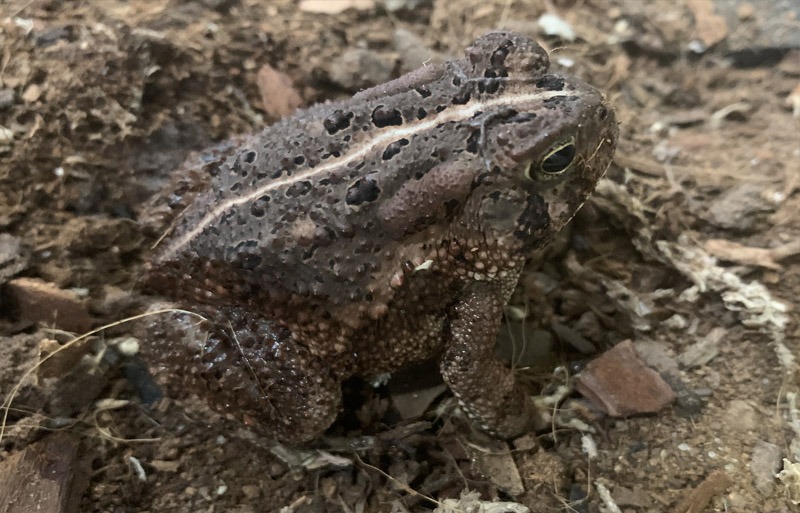
Toads are ambush predators. They burrow into the ground and wait for something to walk in front of them and, using their long tongue, snatch up unsuspecting prey in the blink of an eye.
The length of their tongue varies from species to species, but some of them can reach up to twice their body length or more.
I’ve made a list including all the various types of insects, reptiles, and small mammals that are on the menu for toads around the world. See the list below.
- Crickets
- Flies
- Worms
- Spiders
- Grubs
- Slugs
- Snails
- Mice
- Lizards
- Snakes
- Small Fish
- Other toads and frogs
Large toads have been known to eat small mammals such as mice. Small lizards and even snakes become fair game, too.
An interesting fact about toads is that they have to swallow their prey whole. They don’t chew their food – they swallow it whole. Meanwhile, some frogs have teeth but toads do not.
What Toads Eat in Captivity
Toads in captivity eat all the foods they would in the wild. The only difference is, obtaining insects, small fish, or mice isn’t appealing to most people.
For that reason, toads in captivity are often limited to what you can purchase in a pet store or cultivate on your own. Most people feed them crickets and worms in captivity because that’s about all you can buy in (most) pet stores.


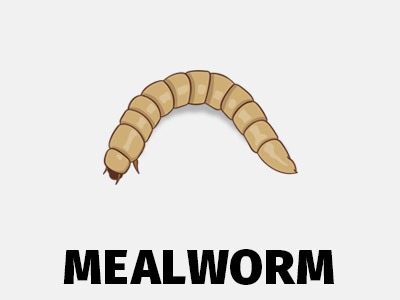
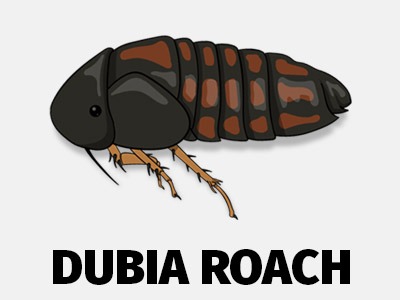
Otherwise, you can go out and catch the insects, small reptiles, and baby mice yourself (kidding). You don’t have to do this. In fact, don’t do this unless your pet toad is native to the region of the world you live in!
In short, you’ll want to feed them the things you can easily obtain from your local pet store.
Here is a list of things toads eat in captivity
- Crickets
- Mealworms, super worms, waxworms
- Earthworms
- Dubia Roaches
- Feeder Fish
Perhaps the best thing you can feed your captive toad is live crickets. Most pet stores raise crickets for the purpose of feeding reptiles and amphibians.
Crickets raised in captivity don’t contain as many nutrients as wild crickets. For this reason, it’s important to gut load the crickets before feeding them to your pet toad.
Dusting the crickets with a calcium and vitamin supplement is highly recommended.
In captivity, toads don’t have access to their natural habitat (which is perfect for them). The insects and little critters they eat are healthy and they’re hopping around in the sun, soaking up UVB.
Ultraviolet B is thought to help reptiles and amphibians metabolize vitamins and calcium. Calcium is important for the bones of your toad and it’s something that can become a health issue if you don’t use supplements.
- Check out our care guide for American Toads for more help!
Tadpoles in Captivity
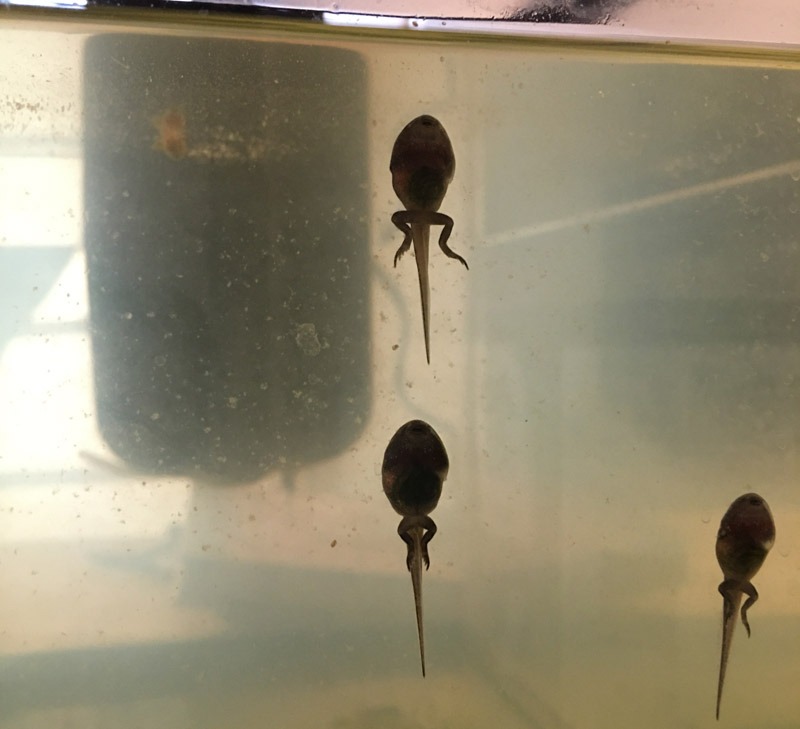
Feeding tadpoles in captivity is a whole topic in itself. It contains a lot of information because rearing tadpoles is tricky. They’re delicate and doing the wrong thing can result in the loss of your tadpoles.
For example, I wrote a giant safe water guide for tadpoles and didn’t even begin to talk about feeding them. Anyway, I’ll lightly cover the topic here but I encourage you to read more about this subject if you’re raising tadpoles!
Tadpoles in captivity do well eating boiled baby spinach and (some) commercial tadpole foods.
- Boiled baby spinach leaves
- Commercial tadpole food
- Boiled eggs
- Decayed plant matter
In my experience, tadpoles preferred baby spinach leaves. I boiled them, let them cool, and placed a small amount into their tank. In addition to the baby spinach leaves, I experimented with adding tadpole pellets.
I got mixed results with the tadpole food and 90% of the time the tadpoles simply ate the boiled spinach leaves.
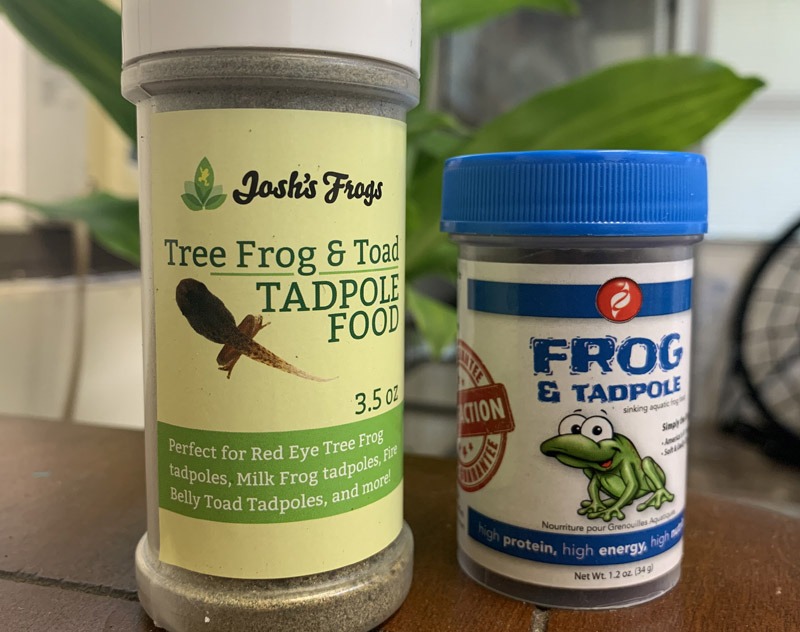
Out of the two brands in the picture above, Josh’s Frogs tadpole food (link goes to Amazon) performed the best. Both worked well. Still, as I mentioned earlier, baby spinach leaves were the preferred source of food for the last batch of tadpoles I raised.
Feed tadpoles 2 – 3 times each day and perform partial water changes as needed.
It’s important to clean up the leftover food after feeding. In addition to this, don’t overfeed them! Any leftover food will only cause you to have to clean the water more often.
Juvenile Toads in Captivity
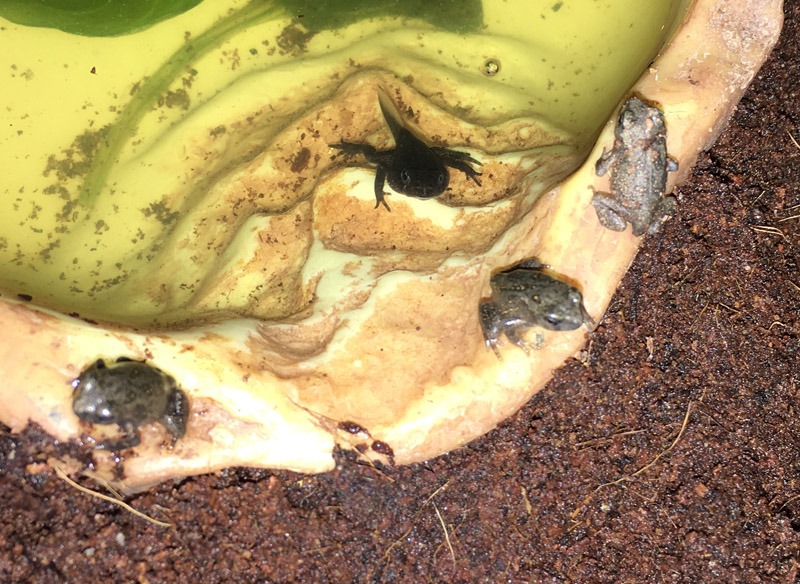
Whether you’ve successfully raised toads through the tadpole stage or bought a young, exotic toad at a pet show, it’s time to learn what to feed them!
Juvenile toads aren’t fully developed yet – they still have a small mouth. Due to this, you must not feed them insects that are too large! There is an easy rule to follow when feeding all frogs and toads.
Feeder insects should not be bigger than the distance between a toad’s eyes.
Simple, right? If the distance between your toad’s eyes is about 1/4″, then you’ll want to get crickets no bigger than 1/4″ in length. Listed below are my two favorite insects to give young toads.
- Pinhead crickets
- Wingless fruit flies
- Small invertebrates
Feed juvenile toads every day or every other day. You have to experiment with the number of crickets (or flies) you give them each feeding.
5 – 6 pinhead crickets may suffice for a small juvenile toad but not one nearing maturity. As they grow in size, they need bigger crickets or more pinhead crickets.
Watch your toad and see whether or not they eat all the crickets (or flies) you give them within an hour or two. If they eat all of them, you can increase the number of insects you give them on the next feeding.
Common Feeding Mistakes
There are several things you should avoid doing when feeding a pet toad. These mistakes are common and often result in the declining health of your beloved pet.
- Using wild-caught insects
- Not utilizing supplements
- Feeding dead insects
- Overfeeding / Underfeeding
- Using the wrong size of feeder insects
Using wild-caught insects (the ones you can find in your backyard) is a common mistake made by those new to the hobby. The reason this is a bad idea is that it can lead to a parasitic infection. The reason? Little parasites in the bugs can have a negative impact on toads that aren’t native to the surrounding area.
Not utilizing supplements is another mistake. Because your pet frog doesn’t have access to the large variety of foods they would have in the wild, their health can suffer. The crickets and mealworms you get from the pet store are typically low in nutritional value. That’s why it’s important to gut load feeder insects and dust them with vitamin and calcium supplements!
Most toads won’t knowingly eat dead feeder insects. They thrive on healthy, living insects and small animals!
Toads are known to have ferocious appetites. They eat and eat and eat. Overfeeding them is a real possibility. Obesity can lead to a shorter lifespan if gone untreated.
Finally, feeding a juvenile toad a large cricket can be problematic. Not only will the toad try to eat the cricket but it could injure itself (or choke) while trying to swallow something too big.
Some Toads Are Cannibals
If you look back to the section with the bullet list of foods, you may remember seeing “other toads and frogs”. Well, it’s true.
Some toads, like cane toads, are cannibalistic. They eat their own kind. Large, full-grown toads sometimes eat smaller toads and frogs. If they’re hungry and it will fit in their mouth – it’s dinner.
Another species known for eating its own kind is the Pacman Frog. While they’re not toads, I felt it’s worth mentioning because they’re extremely popular as pets.
That doesn’t mean every toad is a cannibal – only some of them are. Cane toads, as I already mentioned, are one of them!
How Toads Eat
How toads eat is more fascinating than what they eat (in my opinion). I’ll quickly cover the basics.
- Their tongue deforms and shoots out of their mouth in the blink of an eye. The tongue is coated in a sticky, honey-like spit that causes bugs to stick to it. Once the bug is stuck, the toad’s tongue springs back into its mouth like a bungee.
- After the toad retrieves the bug into its mouth, it’s time to swallow. This is where it gets more interesting. The toad uses its tongue AND eyes to move the bug down its throat. That’s right, toads use their eyes to swallow food! Their eyes are used to push the food down into their throat.
Toads close their eyes while swallowing and often just before they attempt to catch prey using their tongue.
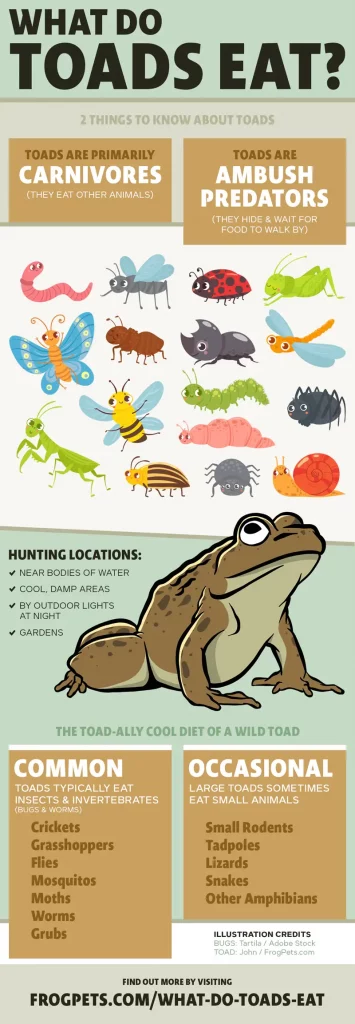
Feel free to share this infographic on social media. You may use it on your website or blog, as long as it links back to this page.
TLDR; What Do Toads Eat?
A toad will eat nearly anything it can fit in its mouth. They become carnivores after metamorphosis, eating live insects and invertebrates like crickets, flies, worms, and spiders. Large toads are capable of eating small mice, lizards, snakes, and other amphibians.
Many true toads, those in the Bufonidae family, burrow into the dirt and wait for their prey to come to them; they are ambush predators. Their quick reaction time and long tongues help them to reach out and grab their target.
If you’re reading this because you’ve recently acquired a new pet toad, please heed my advice and use reptile vitamin & calcium supplements! Dusting feeder insects with calcium and vitamin
Interested in keeping a toad as your pet? Check out our beginner’s guide to keeping frogs and search for a care guide that teaches you everything you need to know for proper toad husbandry!
Anyway, I hope this information was helpful to you! If you have any questions, feel free to ask in the comment section below.

48 Comments
Concerned juvenile toad owner.
Hi we acquired a tadpole from a swimming pool. Somehow it survived and recently morphed into a ver tiny toad the size of my pinky fingernail. It seems to be doing well, but I am concerned that it may not be eating. I have flightless fruit flies in with the toadlet, but they don’t seem to be eaten and with the “dirt base I have in there I can’t tell if any have died or not. The toadlet is too tiny to eat anything larger. Out of concern I have been putting some of the tadpole/frog food pellets on the toadlet’s rock. The pellets seem to be disappearing though I have noticed the fruit flies going after them though I would be surprised if they could actually eat them. Is it possible the toadlet is in fact eating the pellets? I would hate for the toadlet to be unknowingly starving, but when I tried putting it in a smaller clear container with the fruit it ignored them even when they crawled on it. Any advice or suggestions would be greatly appreciated. We are in this for the long haul and want to keep the toadlet as a pet. Thank you.
I have a toad in my courtyard.
It cannot get out. I have constructed a small pond like area for it as well as a cozy toad abode, and access to sun and shade and tree roots for digging down in. I have a garden full of plants and do also have worms and ants and currently midges or gnats. Is that enough to keep it happy and healthy?
I would imagine so. It’s an open courtyard, yes? If so, there should be a number of wild insects in the area to keep the toad healthy!
My tadpoles will soon mature into toads and I have been wondering if it will bo good to feed them ants and termites
Hey, Kim! Wingless fruit flies or pinhead crickets are two popular options and you don’t have to worry about them.
I acquired a wild pet toad whom I think is a girl and is a southern toad. I am unsure how much to feed her and how many times a week as I am unsure of her age. She is not very big right now so I’m thinking she is only a couple months to a year. Can I feed her human food some too? And if so what kind?
I don’t recommend giving your toad human food. Stick to live insects like crickets, Dubia roaches, mealworms, etc. Here is more information on what to feed frogs.
found a really small toad and i know my mom wont let me keep him i put small small pieces of fruit and im going to see if it eats it what should i do next?
Sorry your mom won’t allow you to keep one! Toads typically eat live prey. I recommend waiting until your mom will let you keep one, then do a bunch of research on how to properly care for the type of frog you’re keeping. Then go out and get one! Best wishes and good luck!
I have a smallish road that we found last week. I gave him 3 crickets and they were gone in a few hours. I picked up a few more crickets today and put them in his habitat. Do toads know when stop eating? Should I take the remaining crickets out?
Some amphibians stop eating when they’re full. Others, not so much. Toads are prone to over eating so it’s a good idea to monitor their intake. If they’re getting overweight, feed them a few less crickets!
My stepsister found a big toad and 3 small toads and she doesn’t know what to feed them
Show her this page! You might find the information on this page helpful as well.
I found a toad in my backyard and loves my Jacuzzi…I found his home underneath a cement slab that my water pump is placed on…he gives me the goose bumps when I take out my jacuzzi and don’t know what to do with it…I tried to catch it but got away.
Hey Maria! If he’s bothering you, I recommend getting a small net. That should help you catch him. You can relocate him somewhere out of your yard and maybe he/she won’t come back lol.
I have one big toad and two small toes what do Feed them
Sorry I meant to say two small toads One big toad
Most of that information is on this page. Also, check the American toad care sheet and “what do frogs eat” For more helpful information.
Hes also a baby
Very interesting!
I’m a teen,and me and my little brother caught a toad is small and fits in one Palm,I’ve feed it ants and a beetle it at the ants quick but the beetle has been there for a couple hours…I thought it might be full but I only gave it about 6 ants…but they were larger…And I have a piece of raw chicken dangling on a string in the cage George ( toad) will nip at it but not eat it… Do you have any other explanations/advice? And do frogs eat rice? If so what kind cooked,raw,jasmine,ect
Please do some research on keeping frogs. Those found in the wild have a hard time adapting to captivity. Also, you will benefit from knowing what frogs eat.
Do toads have warts on their tounges?
Is it possible for a toad to get tooo much calcium?… I mean if a toad is eating only wild outdoor bugs just fine, would dusting in calcium be needed ? And not getting sunlight… matters?.. Would that shorten his life span.. ? Or can he become ill.?
I have a toad that won’t eat crickets, and I ordered meal worms but they won’t arrive for a while. I need to feed him, should I give him fruits and vegetables? And if so, what kinds?
It’s rare to get toads to eat fruits or vegetables. Should you try, make sure they’re chopped into small pieces. Small enough for the toad to eat. I’m not sure why he/she won’t eat live crickets. Live crickets or meal worms are one of the best options. They most likely won’t eat dead bugs either.
I recently got a small toad, but not super tiny. How often should I feed her, and what size should the mealworms be?
hay i got a big toad i found it on my porch stair dont know wht it is
Recently, my kids brought home a toad, and I’m not sure how old he is, or what kind he is
You could probably narrow it down to a handful of different species based on where you live in the world.
I have a small toad that’s red and I don’t know what to feed it
Feed him pinhead crickets, fruit flies, or tiny meal worms.
ok question i have 4 baby toads bout month old and ive run out of crickets what can i feed them out of desperation while waiting for crickets?
Wingless fruit flies is the best option I can think of. Also, you could try small pieces of worms.
I have a toad that has bumps on his body and he is grey and blackish.
My daughter found a smaller American toad a few days ago. First, we tried meal worms from petco , but the toad would not eat. So next I got a small earth worm and a good size grub. He ate those right up. The following day we couldn’t find any. We went back to the pet store and were able to find red wrigglers. They look a lot like earthworms, but skinnier…. were waiting for toad to eat. If toad doesn’t eat… is it because toad only wants outside wild insects??
They eat a variety of insects in the wild. The large variety helps them stay healthy. I’m not entirely sure why it wouldn’t eat the mealworms. One thing you can do is check your local Walmart’s fishing section for live worms.
I recently caught a big toad in my yard and my son wanted to keep him as a pet. So far it’s been going well, but I have a question about his diet. I’ve recently started feeding him wasps that get into the house by slapping them with my hat and putting them in the aquarium before they regain their mobility. He loves to chase them down and eat them, but I was wondering if wasps could hurt him by stinging his insides, or by ingestion of the wasps toxins. I haven’t found any answers online so any advice would be greatly appreciated.
Wow that’s a great question. I’m not sure to be honest.
I don’t know a lot about wasps but I bet their sting works similar to a snake or spider (in terms of deliver). They’re venomous – not necessarily poisonous. Venom is injected via a stinger, fangs, etc. Poison is absorbed or consumed.
Like you said, it’s stinger could be problematic. I’ll try and find some info on this subject as well.
In the meantime, I’ll tell you that captive frogs almost always require supplements (vitamins and calcium) to remain healthy. This is because they don’t have access to the wide variety of things they would normally eat in the wild.
“Dusting” live crickets with reptile vitamins and calcium is common practice for toads and frogs in captivity. It’s especially important for their bones.
Is it possible for a toad to get tooo much calcium?… I mean if a toad is eating only wild outdoor bugs just fine, would dusting in calcium be needed ? And not getting sunlight… matters?.. Would that shorten his life span.. ? Or can he become ill.?
That’s a good question. It’s a topic that doesn’t have a lot of accurate information. I’ve read studies about reptiles eating crickets dusted with calcium powder and also being exposed to UVB lights. The outcome was interesting. The reptile exposed to more D3/calcium actually ate fewer crickets. This suggested that the test subjects that weren’t getting as much calcium were trying to make up for it by eating more crickets. I’m sorry I can’t be more helpful but I hope this helps.
I have a toad and found him on my Trampoline and his name is Joe Roo Boggsapenny and yeah.
Thank u for the info I needed to no what to feed my new juvenile toad named rascal,he’s so small
Hey no problem!
Me and my grandparents found two toads in the basment shower and they have been with them for about two months and one recently dissapered. We’re pretty sure they are girl and boy what do you think happend to the one that vanished? and also the one here is not scared of us any more should we let it go hibernate or can it survive in the house? if so what do we feed it?
Are there any insects..poisonous or predatory or otherwise toward toads? Are there insects he should never eat?
Good question?
Hi I caught a toad yesterday and it is smallish I keep it out Side and me and my sister found that king George (toad) has a hurt hand and it was bleeding question: Will it die?